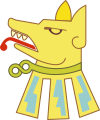Neza
|
Nezahualcóyotl Ciudad Nezahualcóyotl |
||
|---|---|---|
| City & Municipality | ||
| Nezahualcóyotl | ||

Municipal Palace of Nezahualcóyotl
|
||
|
||
 Nezahualcóyotl location in the State of Mexico |
||
| Coordinates: 19°24′00″N 98°59′20″W / 19.40000°N 98.98889°W | ||
| Country |
|
|
| State |
|
|
| Metro area | Greater Mexico City | |
| Municipal Status | April 23, 1963 | |
| Municipal Seat | Ciudad Nezahualcóyotl | |
| Government | ||
| • Type | Ayuntamiento | |
| • Municipal President | Juan Hugo de la Rosa García (2016-2018) | |
| Area | ||
| • Total | 63.74 km2 (24.61 sq mi) | |
| • Water | 0.62 km2 (0.24 sq mi) | |
| Elevation (of seat) | 2,220 m (7,280 ft) | |
| Population (2010 Census) | ||
| • Total | 1,110,565 | |
| • Density | 17,423.4/km2 (45,126.6/sq mi) | |
| Time zone | CST (UTC−6) | |
| • Summer (DST) | CDT (UTC−5) | |
| Postal code (of seat) | 57000 | |
| Area code(s) | 55 | |
| Demonym | Nezahualquense | |
| Website | Official website (in Spanish) | |
Ciudad Nezahualcóyotl (Spanish pronunciation: [sjuˈðað nesawalˈkoʝotɬ]), or more commonly Ciudad Neza, is a city and municipality of State of Mexico adjacent to the northeast corner of Mexico City: it is thus part of the Mexico City Metropolitan Area. It was named after Nezahualcoyotl, the Acolhua poet and king of nearby Texcoco, and was built on the drained bed of Lake Texcoco. The name Nezahualcóyotl comes from Nahuatl, meaning "fasting coyote."
Until the 20th century, the land on which Ciudad Neza sits was under Lake Texcoco and uninhabited. Successful draining of the lake in the early 20th century created new land, which the government eventually sold into private hands. However, public services such as adequate potable water, electricity and sewerage were lacking until after the area was made an independent municipality in 1963. Today Ciudad Neza is a sprawling city of over one million entirely with modern buildings.
As of 2006, Nezahualcóyotl included part of the world's largest mega-slum, along with Chalco and Izta. Most of its population is poor and have migrated from other parts of Mexico. It also has a very high crime rate, in part due to "cholos" or gangs formed since the 1990s based on gang models in the United States, especially Los Angeles. Since the 2000s, a significant number of natives of this city have immigrated to the United States, mostly settling in New York. This has led to a new Mexican subculture in the area.
...
Wikipedia

